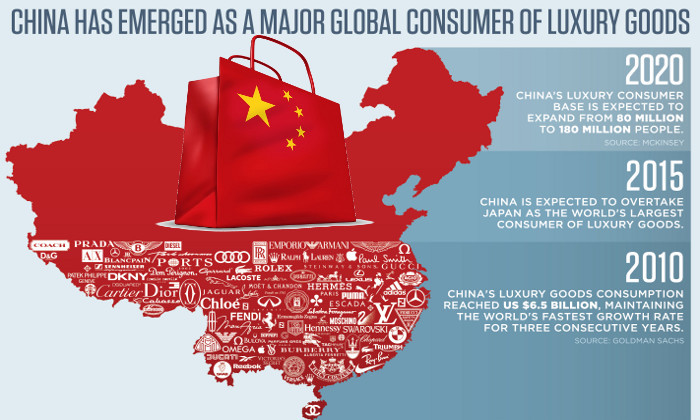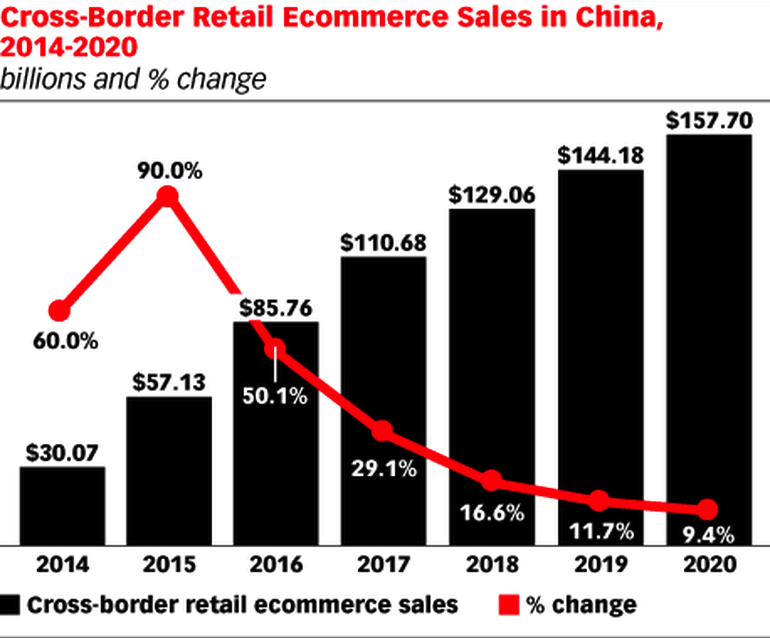China
million
Chinese people
million
Chinese online
million USD: total revenue
cross border purchases
million USD: total revenue
online shopping in China
The Chinese E-Commerce market and Cross Border trade
The Chinese E-Commerce market is growing so fast that figures are out of date almost as soon as they are released.
Let’s take a moment to consider the potential size of the market – the population of China is approaching 1.4 billion people. That’s around 18.5% of the world’s population. With internet penetration now approaching 50% that means there are now 688.69 million Chinese people online.
It is not only the vast size of the market that makes it so attractive for foreign retailers. But also the wealth and spend of the Chinese consumers. The online purchase of luxury goods is increasing fast and the Chinese online shopper spends considerably more online than we do in the West. Put simply, the Chinese are crazy for shopping and crazy for e-commerce.
• Online shopping in China totalled USD $589.61 billion in 2015
• 12.9% of all retail in China comes from e-commerce
• This percentage has been growing at an average rate of 53% year-over-year
The nature of the market combined with the immense size and staggering growth rate makes China, without a doubt, the place to be for foreign e-tailers.

Global e-commerce total
comes from China
Chinese people online
Yearly average increase
Chinese online shoppers
Chinese shopping online
via mobile
E-commerce is becoming a way of life for the Chinese. Practicality, price comparison and better access to other markets have all played their part in its growth. And it’s not just within its own borders that the Chinese are looking to shop. More and more crossborder commerce is taking place.
The 2016 China e-commerce market has become the largest in the world and is projected to total $1.6 trillion in approximately two years.
Online sales of physical products in China grew 31.6% to over USD $589 billion in 2015 from 2014. In 2014, 32% of respondents to a shopper survey said they had purchased overseas goods online. That number doubled in 2015. 58% of online shoppers in China have purchased from overseas.

The average online shopper in China spends 176% more per purchase when buying from overseas than domestically. And 11% makes purchases over ¥ 5,000 (USD $782) and a quarter spend between ¥ 1,000 - 3,000 (USD $156 - $469) per international purchase.
These numbers are linked to people currently connected to the internet in China, be it via computers or smartphones – by the close of 2015, there were 688 million Internet users in the country. According to data from the China Internet Network Information Center, the number of online shoppers topped 413.3 million in 2015, accounting for 60% of all internet users. By 2020, 750 million Chinese are predicted to shop online. Among these online customers, the largest segment is the young and well-educated with a high value of purchasing power. In 2015, men made up 57.1% of online shoppers, surpassing women by 14.2 points, with those aged 20-29 the most prominent. Meanwhile, college graduates represent 74.2% of online shoppers.

Forget tiny little Black Friday. China's Single's Day, the world's biggest online shopping day of the year, has finished last year with Chinese shoppers spending $17.8 billion in 24 hours.
More than $12 billion was spent on shopping website Alibaba in the first 12 hours of Single's Day. It surpassed $7 billion in the first two hours alone and that's just one website...
Single's Day started as an obscure "anti-Valentine's" celebration for single people when students started celebrating their singledom back in the 1990s, but it has spawned into the world's biggest online shopping day. It takes place in China on November 11 every year.
Singles Day laughs in the face of Black Friday. In 2015, Chinese consumers treated themselves to almost $14.2 billion worth of goods from Alibaba in just 24 hours. Last year, Alibaba surpassed that total within 15 hours. This resulted in 467 million parcels being delivered after 710 million payments were made. That was an increase of 60% on 2014, and more than double the total online sales from Thanksgiving, Black Friday and Cyber Monday combined in the US in 2015, according to a report by Fortune.

Since more Chinese consumers are pursuing a higher standard of living and is exposed to foreign products, cross border e-commerce is a rising business right now in China market.
It is estimated that more than 15% of the Chinese population would make cross border e-commerce purchases worth USD $85.76 billion in 2016. This was expected to increase to a quarter of the population by 2020, accounting for more than half of all digital buyers in the country. More specifically, China, which can leverage its manufacturing hub and market size. However, e-commerce sites in the region should first resolve key challenges with user interface, service support, and logistics.
Online shoppers in China were expected to spend an average USD $473.26 each in 2016 on goods outside the domestic market, accounting for 4.2% of total retail e-commerce purchases, according to a report. The report also mentioned that online shopping in China increased by more than 70% last year, fueled by a higher standard of living and greater exposure to foreign products.
This significant market growth was further driven by the launch of Alibaba’s Tmall Global in 2014 as well as JD Worldwide in 2015, paving the way for foreign brands to peddle their wares directly to online shoppers in China. Local consumers in search of better quality goods and more trustworthy brands, particularly in categories such as infant products, also looked for foreign retailers. Cross Border E-Commerce has a bright future in China
In the future, cross border e-commerce goods sold via B2C channel are expected to take up a growing share of the total cross border e-commerce market in 2016 as consumers shift to platforms that are more professional and organised. One major reason is that merchants selling on these B2C platforms have to be authorised, so they are considered more trustworthy. According to a March report from Forrester, China’s e-commerce market was projected to climb to USD $1.1 trillion in 2020, leading the region’s growth to become nine times larger than Japan’s USD $122 billion market and 17 times larger than South Korea’s USD $65 billion.

The size and growth rate of the E-Commerce market in China is unique.
With more than 688 million Internet users, China has more users online than the USA has inhabitants.
The opportunities for business are diverse and almost unlimited.



